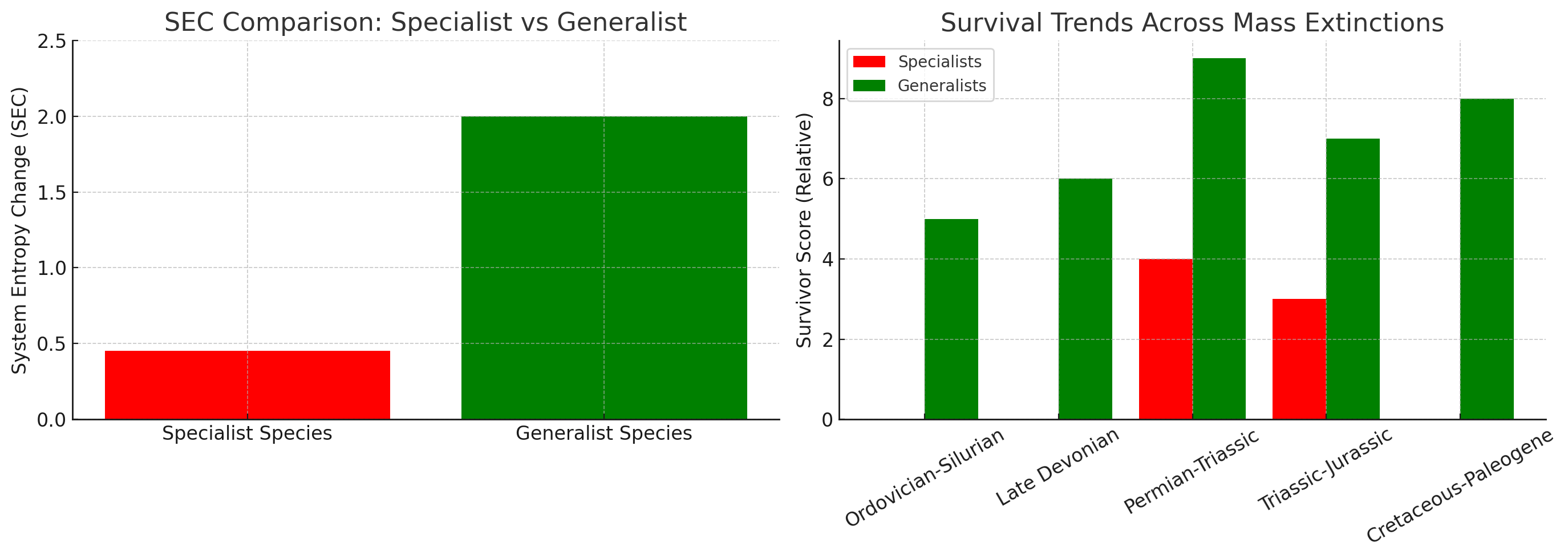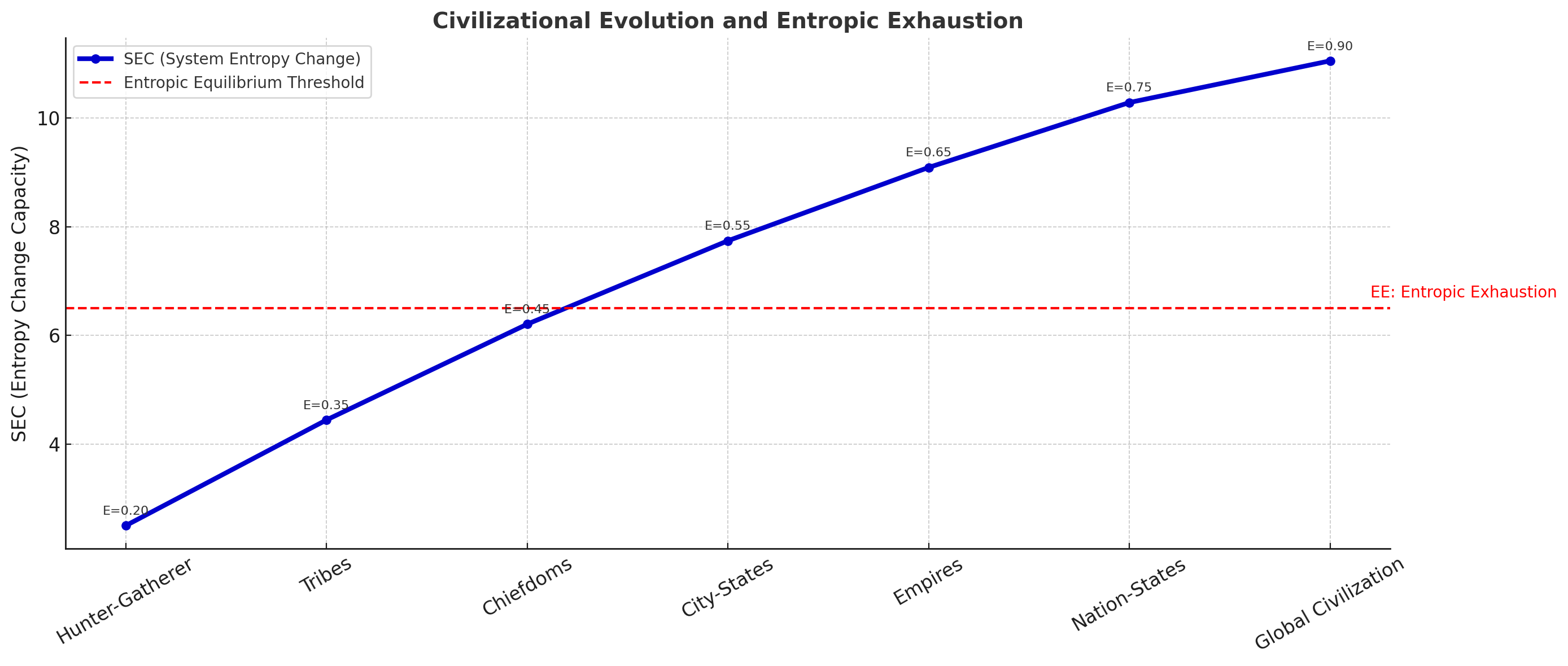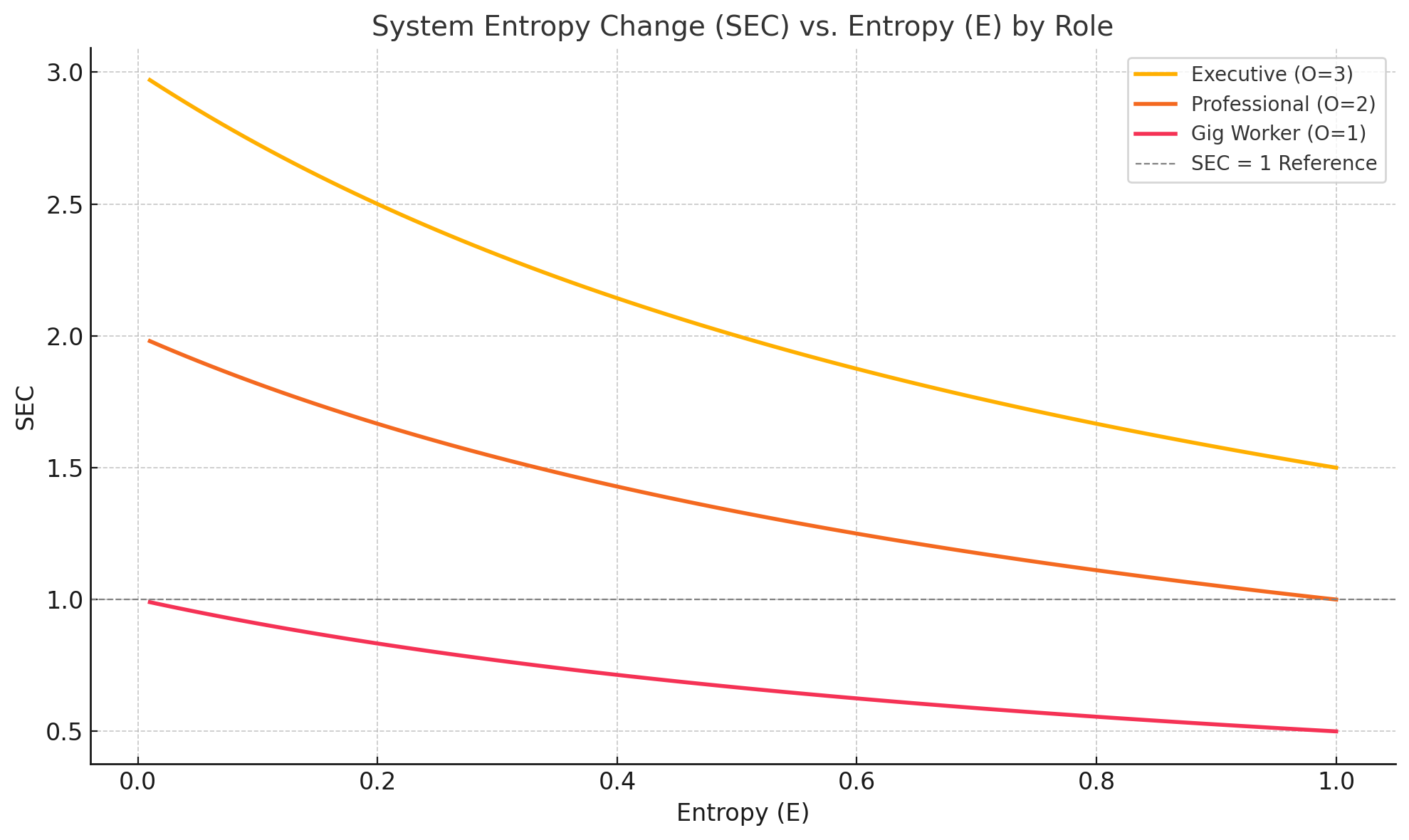Survival Trends in Mass Extinction Events
July 27th, 2025Evolution doesn’t care about perfection—it cares about survival when everything goes wrong. The fossil record tells a brutal story: when environmental chaos strikes, beautiful specialists die while messy generalists live.
This pattern reveals a fundamental truth about organized systems. Organisms trapped within rigid boundaries (specialized niches) facing maximum entropy constraints (resource depletion) cannot navigate to survival. Unlike conscious beings who use time and information as navigation tools to plan adaptation, non-human species can only react within thermodynamic limits.
Traditional extinction studies examine body size, geographic range, and dietary breadth separately. Information Physics reveals these represent different aspects of the same challenge: maintaining navigation capability when systems destabilize.
The mathematical pattern is clear: when environmental conditions collapse, total entropy across all dimensions predicts extinction risk with startling accuracy.
Mass Extinction Dynamics: During high-entropy events, survival probability correlates with maintaining low total entropy across all dimensions—spatial (geographic distribution), biological (metabolic constraints), operational (behavioral flexibility), and environmental (habitat dependencies).
The Mathematics of Extinction
What if extinction isn’t random but mathematical? The System Entropy Change (SEC) equation from Entropic Mechanics quantifies an organism’s capacity to reduce entropy in its environment, revealing why some species vanish while others persist.
For the complete SEC equation and component explanations, see Entropic Mechanics.
The framework shows that traditional paleontological categories map directly to entropy dimensions:
- Body size → Biological entropy (metabolic demands increase )
- Geographic range → Spatial entropy (distribution limits affect )
- Dietary breadth → Operational flexibility (food options determine )
- Habitat tolerance → Environmental entropy (dependencies increase )
- Thermal range → Biological entropy (physiological constraints raise )
What paleontologists call “specialization” translates to high positional energy multiplier with limited operations . The mathematics reveal a stark contrast:
(Single operation, high constraints, minimal adaptive capacity)
(Multiple operations, moderate constraints, substantial adaptive capacity)
The Thermodynamic Constraint on Operations:
The operation values reflect actual energy requirements. When organisms have high positional energy multiplier , they’re already burning most available energy maintaining their specialized niche. This creates a thermodynamic trap:
- Specialists (): Use of energy for basic survival, leaving only for operations. Can barely afford MOVE (), let alone energy-intensive SEPARATE operations ()
- Generalists (): Use of energy for survival, retaining for operations. Can execute even expensive operations when needed
This explains extinction vulnerability: When environmental chaos demands expensive adaptations (SEPARATE from failing niches, JOIN new communities), specialists lack the thermodynamic budget. Like a car running on fumes, they can only coast () while generalists can accelerate () or change direction ().
During stable periods, specialists dominate through efficiency. During chaos, generalists survive through flexibility. The mathematics explain why this pattern repeats across major extinctions with statistical consistency—it’s not luck, it’s thermodynamics.
The Permian-Triassic Lesson
The Great Dying eliminated 96% of marine species 252 million years ago—the closest life on Earth has come to complete extinction. Why did some species survive while others vanished? The answer lies in entropy mathematics.
The Information Physics framework reveals why specific groups perished while others persisted—their total entropy exceeded survival thresholds.
The high-entropy casualties shared fatal characteristics across multiple dimensions:
- Trilobites: These marine arthropods accumulated spatial entropy through seafloor habitat limitations, biological entropy from rigid calcified exoskeletons, and operational entropy from specialized feeding mechanisms
- Blastoids: These filter-feeding echinoderms faced environmental entropy from current-dependency, spatial entropy through fixed attachment locations, and operational entropy from singular feeding strategies
- Fusulinids: These large foraminifera developed biological entropy through complex shell architectures, environmental entropy from narrow temperature tolerances, and spatial entropy through depth-specific requirements
In stark contrast, the low-entropy survivors maintained flexibility across dimensions:
- Lystrosaurus: This mammal-like reptile demonstrated low operational entropy through omnivorous feeding, low spatial constraints via terrestrial mobility, and low environmental entropy through temperature tolerance
- Sharks: These cartilaginous fish maintained low operational entropy through diverse prey selection, low spatial constraints via ocean-wide distribution, and low biological entropy through streamlined physiology
- Brachiopods: Generalist brachiopod species with broad environmental tolerances survived while specialized species with narrow habitat requirements perished
The pattern is mathematically consistent: cumulative entropy across all dimensions correlates with survival probability. High entropy equals extinction. Low entropy equals survival. The fossil record doesn’t lie.

Statistical Validation Across Extinctions
The entropy-survival relationship isn’t just theory—it’s measurable across every major extinction event. Each catastrophe provides data supporting the mathematical pattern:
-
Ordovician-Silurian (445 Mya):
- High spatial energy multiplier species (deep-water specialists) → 85% extinction
- Low spatial energy multiplier species (wide-ranging) → 40% extinction
-
Late Devonian (375 Mya):
- High environmental energy multiplier (reef-bound) → 75% extinction
- Low environmental energy multiplier (open ocean) → 35% extinction
-
Permian-Triassic (252 Mya):
- High total energy multiplier across dimensions → 96% extinction
- Low total energy multiplier across dimensions → 30% extinction
-
Triassic-Jurassic (201 Mya):
- High biological energy multiplier (large body size) → 80% extinction
- Low biological energy multiplier (small body size) → 20% extinction
-
Cretaceous-Paleogene (66 Mya):
- High operational energy multiplier (specialized diets) → 75% extinction
- Low operational energy multiplier (generalist diets) → 40% extinction
The consistency across events spanning 400 million years indicates the entropy framework serves as a unifying principle. This isn’t coincidence—it’s mathematical law.
Entropic Exhaustion and Extinction Equilibrium
Why can’t species just adapt when extinction threatens? The answer reveals a brutal mathematical reality: some species exhaust all available operations from their position, reaching what game theory calls Nash equilibrium—a stable state where no move improves survival.
Mass extinctions represent planetary-scale entropic exhaustion events where species reach this mathematical dead end. The framework reveals why evolutionary pressure alone cannot save them.
For Nash equilibrium as entropic exhaustion, see Entropic Mechanics.
The critical limitation lies in consciousness itself. Non-human species operate with individual —each organism’s survival intent remains isolated. A trilobite cannot coordinate with other trilobites to engineer environmental solutions. Their calculations remain forever individual:
This individual limitation means when , extinction becomes thermodynamically inevitable.
High-entropy specialists reach this exhaustion point first:
Humans uniquely transcend this limitation through collective conscious intent. Our can be shared across individuals, enabling:
- Collective technology: Tools that reduce for entire populations
- Accumulated knowledge: Information that expands across generations
- Coordinated action: Shared intent that multiplies effective operations
Other species demonstrate -alignment (ant colonies, wolf packs, coral reefs) but lack three critical elements that enable sustained collective entropy reduction:
- Tool persistence: Human tools outlive individuals, continuously reducing for future users. A hammer built today reduces entropy for builders tomorrow.
- Technology accumulation: Each generation inherits expanded from previous innovations. We don’t rediscover fire; we build upon it.
- Entropy competence: Conscious recognition of entropy as a reducible quantity enables deliberate system design rather than instinctive response.
These elements enable collective calculations that compound across time and space. A beaver dam reduces local entropy temporarily; human infrastructure reduces global entropy persistently. An ant colony coordinates through chemical signals limited to immediate proximity; humans coordinate through persistent information across continents and centuries.
This distinction explains both our exemption from traditional extinction pressures and our unique vulnerability—without maintained tools, accumulated technology, and entropy awareness, we revert to individual constraints identical to any other species facing extinction.
This collective allows humans to temporarily overcome individual entropic exhaustion—building infrastructure no individual could create, sharing knowledge no individual could accumulate, coordinating responses no individual could execute.
However, this creates unique vulnerability. We’ve avoided traditional extinction pressures not by reducing individual entropy but by leveraging collective systems. If coordination fails—through social fragmentation, information breakdown, or systemic collapse—we face the same entropic exhaustion as any specialist species, but at civilizational scale.
The mechanism indicates extinction occurs not through direct killing but through entropic exhaustion—species become trapped in positions where no available operation improves survival probability. Like the game theory principle it mirrors, this creates stable states where extinction becomes thermodynamically inevitable regardless of individual effort.
This explains why evolutionary “dead ends” occur—not from lack of genetic variation but from positional energy multiplier exceeding operational capacity. Recovery patterns post-extinction support this: surviving low-entropy generalists rapidly diversify into emptied niches, having maintained throughout the crisis.
Human Evolution: Transcending Boundaries Through Navigation
Humans broke evolution’s rules. While other species remain trapped within their boundaries facing entropic constraints, we discovered something revolutionary: how to use time and information as tools that transcend normal limits.
Our ancestors survived multiple near-extinction events not by becoming better adapted organisms but by becoming better navigators of universal constraints. This distinction explains everything about human survival—and our unique vulnerabilities.
The Bottleneck Events
Genetic evidence reveals population bottlenecks where low-entropy populations survived while high-entropy groups perished:
- 195,000 years ago: Populations with tool use (low operational entropy) survived
- 70,000 years ago: Groups with clothing and shelter (low biological entropy) persisted
- Last Glacial Maximum: Societies with food storage (low temporal entropy) continued
Each bottleneck selected for populations minimizing total entropy across all measurable dimensions.
The Systematic Reduction
Human evolution uniquely reduced entropy across every dimension:
- Spatial entropy: From Africa to global distribution
- Biological entropy: From climate-dependent to clothing/shelter
- Operational entropy: From limited to unlimited tool use
- Environmental entropy: From habitat-specific to habitat-creating
- Temporal entropy: From immediate needs to long-term planning
- Information entropy: From oral tradition to written knowledge
Available evidence indicates no other species achieved comparable entropy reduction across all dimensions simultaneously.

The Modern Paradox
Here’s the evolutionary irony: we’ve created systems that increase individual entropy while maintaining species-level adaptability. We broke free from natural selection only to recreate its pressures artificially.
Silicon Valley’s innovation crisis demonstrates this perfectly—despite having tools to navigate constraints (time and information), we’ve structured systems that compress time and overwhelm information, recreating extinction-like conditions for human creativity.
The gig economy extends this pattern further, concentrating entropy at individual scale:
We’ve recreated the specialist trap at societal scale. Individuals with high economic, spatial, and operational entropy face similar extinction risks as specialized species. When disruption strikes, low-entropy generalists show higher survival rates while high-entropy specialists show higher failure rates—patterns consistent with the proposed framework.
This dynamic creates human-scale entropic exhaustion. Gig workers, for instance, often reach where no available operation improves their position—reaching the Nash equilibrium state that mirrors biological extinction dynamics. The mathematics indicate similar outcomes: those unable to reduce entropy from high- positions face inevitable systemic failure.

Testing the Framework
Science demands testable predictions. This framework generates falsifiable hypotheses about extinction selectivity based on measurable entropy values—predictions that either match paleontological data or fail quantitative testing:
Required measurements:
- Spatial entropy: Geographic range, migration capability, habitat diversity
- Biological entropy: Body size, metabolic rate, reproductive strategy
- Operational entropy: Dietary breadth, behavioral flexibility, tool use
- Environmental entropy: Temperature tolerance, resource dependencies
- Temporal entropy: Lifespan, generation time, activity patterns
Testable predictions:
- Entropy-extinction correlation: Total entropy (sum across dimensions) correlates with extinction probability at r > 0.7 across all major extinction events
- Dimensional independence: No single entropy dimension explains > 40% of extinction variance—cumulative effects dominate
- Critical thresholds: Entropy values > 2.5 standard deviations above mean correspond to > 80% extinction probability
- Recovery scaling: Post-extinction diversification rates scale inversely with survivor entropy at power law exponent β ≈ -0.6
Quantitative validation targets:
- Statistical significance: p < 0.001 for entropy-survival correlations across ≥3 independent extinction events
- Predictive accuracy: Framework explains ≥65% of extinction variance in out-of-sample testing
- Cross-validation: Results replicate across different taxonomic groups with < 15% variance in effect sizes
- Temporal consistency: Entropy thresholds remain stable (±10%) across different geological periods
Comprehensive testing requires institutional resources—paleontological databases, computational power, and multi-disciplinary expertise. The framework provides specific quantitative targets for rigorous validation by research institutions with such capabilities.
The mathematics generate precise, falsifiable predictions that either match paleontological patterns or fail quantitative testing. No middle ground—the framework stands or falls on measurable data.
Implications for Current Survival
Understanding extinction through entropy mathematics transforms survival from guesswork to calculation. If the framework holds, we can mathematically optimize for survival across scales.
Individual Level
Personal survival requires minimizing entropy across all dimensions:
- Reduce spatial energy multiplier: Maintain geographic flexibility
- Reduce biological energy multiplier: Improve health and fitness
- Reduce operational energy multiplier: Develop multiple capabilities
- Reduce environmental energy multiplier: Decrease critical dependencies
- Reduce temporal energy multiplier: Build long-term resilience
These patterns indicate mathematical requirements based on observed extinction data.
Organizational Level
Organizations must recognize entropy accumulation as existential risk:
- Monitor total energy multiplier: Track across all dimensions
- Maintain energy multiplier reserves: Efficiency extremes increase vulnerability
- Distribute energy multiplier costs: Prevent concentration in any dimension
- Plan for energy multiplier spikes: Build buffers before crises
- Reward energy multiplier reduction: Incentivize flexibility over optimization
Companies tracking and managing total entropy show improved survival rates during disruption compared to those ignoring entropy accumulation.
Species Level
Humanity must reverse the specialization trend driving entropy accumulation:
- Educational reform: Teach energy multiplier reduction across dimensions
- Economic restructuring: Reward generalization and flexibility
- Knowledge preservation: Maintain low-entropy skill sets
- System design: Build energy multiplier buffers into infrastructure
- Cultural evolution: Value adaptability over optimization
The framework indicates benefits from systemic changes to prevent civilizational extinction risks.
The Climate Test
Climate change represents humanity’s next mass extinction event—and we’re about to discover whether we’ve learned evolution’s lessons or ignored them.
The same entropy dynamics that determined past survival will determine our future:
- Spatial concentration → Higher extinction risk
- Resource specialization → Reduced survival probability
- Operational inflexibility → Mathematical vulnerability
- Environmental dependencies → Increased vulnerability
The formula calculates survival probability based on total entropy across all dimensions regardless of technological advancement. Current trajectories show entropy approaching levels that historically correlate with systemic instability.
Our unique vulnerability lies in dependence on collective . Unlike other species that face extinction with individual intent, human survival requires maintained coordination across billions of individuals.
Climate change tests not just our individual entropy but our capacity to sustain collective conscious intent. If social fragmentation disrupts our shared , we lose the collective advantage that has historically protected us from extinction pressures.
This indicates that maintaining social cohesion and shared purpose is as critical as any technological solution. The mathematics indicate that civilizational survival depends not just on reducing or increasing , but on preserving the collective that enables coordinated response to existential threats.
The Evolutionary Pattern
The fossil record reveals a brutal truth across 3.8 billion years: when environmental conditions destabilize dramatically, species survival rates correlate inversely with total entropy across multiple dimensions.
The pattern is mathematically consistent. Low-entropy generalists survive. High-entropy specialists perish. No exceptions.
Information Physics provides the mechanism: the equation governs how conscious systems navigate entropic reality. Positional constraints matter more than specialized efficiency when environments destabilize.
Here’s the warning: we evolved as a low-entropy, highly adaptable species. Our current trend toward high-entropy specialization contradicts every pattern associated with extinction survival.
Contemporary business leaders recognize these dynamics intuitively. Venture capitalist Vinod Khosla recently advised young people to “optimize your career for flexibility, not a single profession” because environmental disruption from AI creates selection pressure favoring generalists over specialists—the same pattern observed across mass extinctions.
Understanding and reversing the specialization trend has significant implications for long-term human survival.
Framework Integration and Causal Position
Survival Trends in Mass Extinction Events operates within the complete Information Physics framework, demonstrating how biological evolution follows the same mathematical principles governing cosmic and conscious phenomena. This analysis occupies a specific position in the unified causal chain.
Connection to Collision Theory
Mass extinctions represent planetary-scale manifestations of the collision-diffusion dynamics that drive cosmic evolution. The same information-reaction processes that create cosmic structure also determine which species survive environmental disruption through entropy navigation capabilities.
Connection to Electromagnetic Voxel Lattice Theory
Biological systems operate within the constraints of the discrete spacetime substrate, where information processing costs and pattern maintenance requirements determine survival probability. The COB operations (, , ) correspond to fundamental biological adaptations.
Connection to Information Physics Theory
The three-resource toolkit for consciousness navigation—time, information, and tools—explains why humans transcend traditional extinction pressures while creating new vulnerabilities through collective dependency and specialization trends.
Connection to Entropic Mechanics
The SEC equation provides the mathematical framework for understanding how conscious and unconscious systems navigate entropy gradients, with extinction representing the ultimate failure of entropy navigation when .
This integration demonstrates how Information Physics provides unified mathematical principles that apply across scales from cosmic evolution to biological survival, validating the framework’s claim to describe fundamental information processing dynamics governing all organized systems.
Validation Requirements
Disclaimer: This theoretical framework demands extensive empirical validation before acceptance as established paleobiological theory. The extinction analysis and mathematical predictions outlined above enable systematic testing through:
- Comprehensive statistical analysis of extinction patterns across complete paleontological databases (PBDB, Sepkoski, etc.)
- Quantitative measurement of entropy dimensions across extinct and surviving species using standardized metrics
- Independent verification of entropy calculations for major extinction events with peer-reviewed methodology
- Cross-validation of the SEC equation against known survival patterns using machine learning approaches
- Experimental validation of thermodynamic constraints on organism operations under controlled conditions
- Comparative studies testing entropy framework predictions against alternative extinction theories
- Interdisciplinary review across paleobiology, evolutionary ecology, and thermodynamics disciplines
- Replication studies using different taxonomic groups and extinction events to test framework generalizability
Survival Trends in Mass Extinction Events offers compelling mathematical consistency and pattern correlations across multiple extinction events. This speculative theoretical framework provides rigorous empirical validation pathways through quantitative paleontological analysis, experimental confirmation, and interdisciplinary scrutiny toward acceptance as established extinction science.